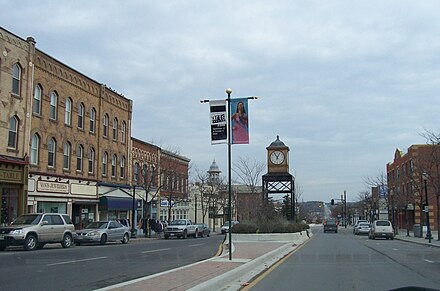Orangeville (Ontario) - town in Ontario, Canada
 Orangeville (29,000 inhabitants in 2016) is about an hour's drive north of Toronto. Orangeville serves as an administrative and commercial hub for Dufferin County, the northern portion of Peel Region and the surrounding area.
Orangeville (29,000 inhabitants in 2016) is about an hour's drive north of Toronto. Orangeville serves as an administrative and commercial hub for Dufferin County, the northern portion of Peel Region and the surrounding area.
Understand
Orangeville's downtown core is home to several retail stores, and there is a cluster of big-box stores in the Fairgrounds Shopping Centre. Many residents in and around Orangeville also commute to other areas of the Greater Toronto Area for work.
There are a number of manufacturing plants in the town. Orangeville is also the main banking centre for residents in the area.
History
The archeological record in Dufferin County dates indigenous occupation of the area to the "early Paleo-Indian" time period from 9000 to 8400 BCE. What eventually became Orangeville and Dufferin County, was historically the traditional territory of the Tionontati or Petún (Tobaco) People. They lived in the mountains south of Nottawasaga Bay, in what are now Grey and Simcoe counties, and farther south at the source of the Grand River in Dufferin County.
The Petún were decimated by European diseases in the 1630s, going from a population of approximately 8000 to 3000, and were attacked by the Iroquois in December 1649 further reducing their numbers to fewer than 1000. They then fled along with other Huron peoples into the United States, while other Petún sought refuge with their French allies and settled in Quebec.
After the decimation and dispersal of the Huron, Petún, and Neutral people of southern Ontario, Algonkian peoples from northern Ontario moved into the area at the end of the 17th century and the beginning of the 18th century, while members of the Three Fires Confederacy (Chippewa, Odawa, Potawatomi) moved into southern Ontario from Ohio and Michigan in the late 1700s. During the pre-confederation Treaty era, Anishinaabe or Chippewa First Nations signed Treaty #18 in, 1818, which included the Dufferin County area. Today, the descendants of Petún call themselves Wyandotte, and despite the 350 years since their displacement from southern Ontario, and despite the heteroglot and diasporic nature of their contemporary communities (in Oklahoma, Michigan, Kansas, and Quebec), they continue to recognize their shared history and are united through a modern-day Wyandotte Confederacy.
Orangeville was named after Orange Lawrence, a businessman born in Connecticut in 1796 who owned several mills in the village. As a young man, he moved to Canada and settled in Halton County. During Mackenzie's rebellion in 1837, he was a captain in the militia. Lawrence purchased the land that became Orangeville from Robert Hughson. The public library, located at Broadway and Mill Street, was completed in 1908. Andrew Carnegie, well-known businessman and philanthropist, provided financial assistance for its construction.
Get in
By bus
- Go Transit provides bus service to Orangeville Monday-Friday, holidays excluded. A trip from Union Station in Toronto would take 2 hours and require a change of bus at the Brampton Bus Terminal.
- TOK Coachlines. Service from Toronto, Kincardine, and Port Elgin. 2021-03-03
- Grey Transit Route. Bus service from Owen Sound. 2021-02-23
Get around
The main intersection in the heart of the town is Broadway (formerly Ontario Highway 9) and First Street. Highway 10 runs through Orangeville on its east side.
- Orangeville Transit. M-F 7:15AM-8:45PM, Sa 7:15AM-6:15PM, no Su or holiday service. Service on three routes throughout town, meeting at the Fourth Avenue transfer point every half hour -- at quarter past the hour and quarter to the hour. Exact fare is required on the transit buses: $2 for adults, $1.50 for seniors and students, children 5 and under are free 2018-06-13
- Orangeville Airport Limo, +1 647-297-1297
See
- Theatre Orangeville, 87 Broadway, +1 519-942-3423 (ext. 2800). Theatre for adults and children in the historic 273-seat Orangeville Town Hall Opera House. Wheelchair accessible, equipped with a hearing accessibility system. 2018-06-13
Do

- Hockley Valley Resort, 43.97762°, -80.04675°, +1 519 942-0754. RR #1, a few km outside Orangeville. Skiing, spa, golf, hotel. Has a good restaurant. From $89 pp, double occupancy for a getaway
- Art Walk of Tree Sculptures. Tree sculpture art on municipal boulevards-- 54 sculptures. Brochure available online. 2018-06-13
Buy
Eat
- Rustik, 199 Broadway, 43.9194626°, -80.0972895°, +1 519 940-3108. M W Th 11AM–3PM, 5PM–9PM; F Sa 11AM–3PM, 5PM–10PM; Su 11AM–3PM, 5PM–8PM. Very good food. 2018-06-13
- The Mono Cliffs Inn, 367006 Mono Centre Rd, 44.0279576°, -80.0709545°, +1 519 941-5109. RR1. Casual and fine dining. 2016-01-13
- Barb's Country Kitchen, 634041 Highway 10, +1 519-938-8282. Daily 7AM-3PM. Diner, burgers. 2018-06-13
Drink
- Mill Creek pub, 28 Mill St, +1 519-307-5700. M-Th 11AM–10PM, F Sa 11AM–midnight, Su noon-9PM. 2018-06-13
- Adamo Estate Winery, 793366 3rd Line EHS, Mono, +1 519-942-3969 x5100. Su M 11AM to 6PM, Tu noon to 7PM, W Th noon to 8PM, F Sa 11AM to 9PM. A small-batch boutique winery offering tastings and tours. 2020-07-03
Sleep
- Hockley Valley Resort (see Do) have packages including rooms, dinner, ski-cards or spa, e.g. two summer nights for two with dinner for $101.
- Best Western Plus Orangeville Inn & Suites, 7 Buena Vista Dr. From $229 2018-06-13
- Atlanta Motel, 316 Broadway Ave, 43.9157°, -80.1130°, +1-519-941-8280. From $82 2018-06-13
Go next
- Cheltenham Badlands - Fascinating landscaping of rolling red gullies created by erosion.
Orangeville
orangeville.caOntario
Primary administrative division